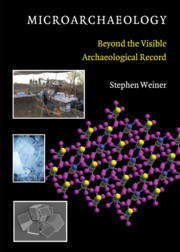Book contents
- Frontmatter
- Contents
- Preface
- 1 Archaeology, Archaeological Science, and Microarchaeology
- 2 Information Embedded in the Microscopic Record
- 3 Completeness of the Archaeological Record
- 4 Common Mineral Components of the Archaeological Record
- 5 Biological Materials: Bones and Teeth
- 6 Biological Materials: Phytoliths, Diatoms, Eggshells, Otoliths, and Mollusk Shells
- 7 Reconstructing Pyrotechnological Processes
- 8 Biological Molecules and Macromolecules: Protected Niches
- 9 Ethnoarchaeology of the Microscopic Record: Learning from the Present
- 10 Absolute Dating: Assessing the Quality of a Date
- 11 Reading the Microscopic Record On-Site
- 12 Infrared Spectroscopy in Archaeology
- Appendix A Identifying Minerals Using Microchemical Analysis
- Appendix B Identifying Minerals and Compounds Using Infrared Spectra: Table of Standard Minerals and Compounds for Which Infrared Spectra Are Available
- References
- Index
- Plates section
1 - Archaeology, Archaeological Science, and Microarchaeology
Published online by Cambridge University Press: 05 June 2012
- Frontmatter
- Contents
- Preface
- 1 Archaeology, Archaeological Science, and Microarchaeology
- 2 Information Embedded in the Microscopic Record
- 3 Completeness of the Archaeological Record
- 4 Common Mineral Components of the Archaeological Record
- 5 Biological Materials: Bones and Teeth
- 6 Biological Materials: Phytoliths, Diatoms, Eggshells, Otoliths, and Mollusk Shells
- 7 Reconstructing Pyrotechnological Processes
- 8 Biological Molecules and Macromolecules: Protected Niches
- 9 Ethnoarchaeology of the Microscopic Record: Learning from the Present
- 10 Absolute Dating: Assessing the Quality of a Date
- 11 Reading the Microscopic Record On-Site
- 12 Infrared Spectroscopy in Archaeology
- Appendix A Identifying Minerals Using Microchemical Analysis
- Appendix B Identifying Minerals and Compounds Using Infrared Spectra: Table of Standard Minerals and Compounds for Which Infrared Spectra Are Available
- References
- Index
- Plates section
Summary
The archaeological record is mainly composed of materials related to past human behavior. Some of these are visible to the naked eye – the so-called macroscopic record – and some require instruments, such as microscopes or spectrometers, to be seen and characterized. This is the so-called microscopic record, and the study of this record is referred to here as microarchaeology.
The macroscopic record is composed of strata, buildings, graves, floors, and so on, as well as artifacts such as pottery, bones, stone, and metal tools. The microscopic record is composed of the materials of which the macroscopic artifacts are made, as well as the sedimentary matrix in which the artifacts are buried. Thus the investigation of the archaeological record as a whole involves the integration of both the macroscopic and microscopic records. It incorporates activities that span the humanities, social sciences, and natural sciences, with the former two disciplines being focused mainly on the macroscopic record and the latter discipline being focused mainly on the microscopic record. Herein lies a problem: the different parts of the archaeological record are studied by investigators with diverse backgrounds and approaches. Often lacking is an integration of these different worlds.
In this book, the focus is on the archaeological information that can be extracted from the microscopic record and, in particular, from the materials commonly found in most archaeological sites such as ceramics, bones, rocks, ash, and sediments.
- Type
- Chapter
- Information
- MicroarchaeologyBeyond the Visible Archaeological Record, pp. 1 - 12Publisher: Cambridge University PressPrint publication year: 2010
- 1
- Cited by

